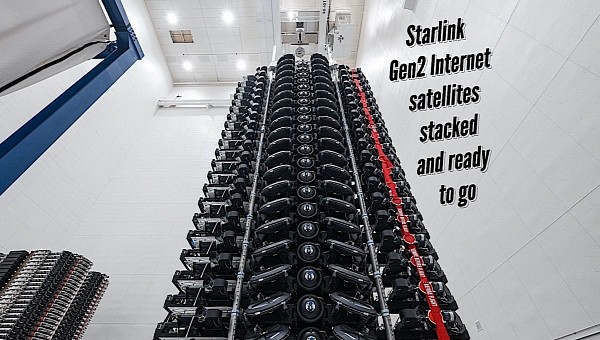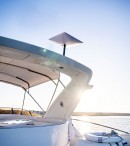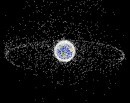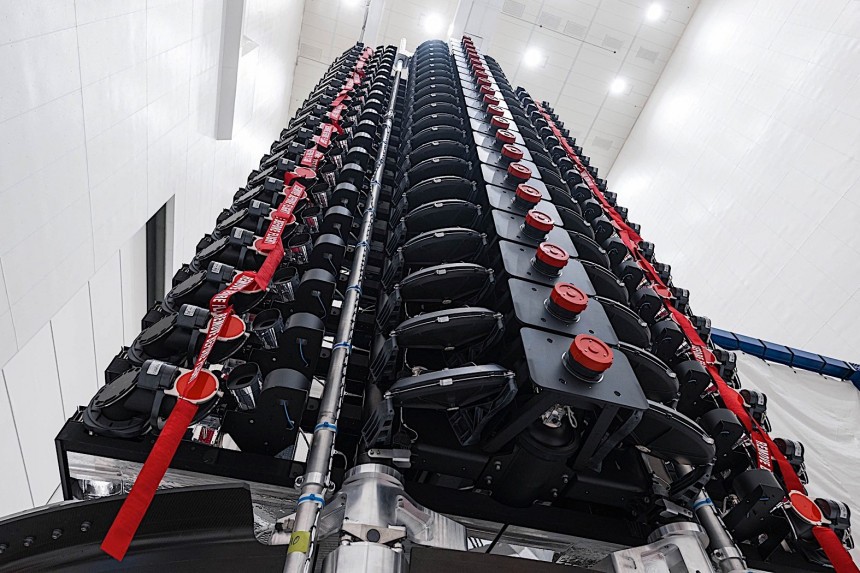If you really think about it, it hasn’t been that long since SpaceX started placing Internet satellites in Earth's orbit. Elon Musk’s company started doing it back in 2019, and the count is already close to 4,000 of them deployed. Sure, that’s still a far cry from the planned constellation of tens of thousands, but impressive nonetheless.
So, from our perspective, Starlinks haven’t been around for all that long, but from a technological standpoint, four years is a lot of time. Satellite internet technology has progressed greatly since the first Starlinks were launched, so some changes were in order.
Enter a Starlink generation SpaceX is calling V2 Mini. Its first examples are scheduled to lift off from Space Launch Complex 40 at Cape Canaveral Space Force Station in Florida later on Monday (1:38 p.m. ET). And they bring with them some serious changes, in terms of both the quality of the Internet they can deliver and their own physical capabilities.
In a series of tweets published a few hours ago at the time of writing, SpaceX gave us a few details on what the V2 Minis are all about. The company talks of key Internet technologies being included, but also about new capabilities for the satellites themselves.
When it comes to doing their jobs, these things come with a set of more powerful phased ray antennas and they use the E-band for backhaul. These new technologies should allow V2s to have four times the capacity of the previous Starlink version. In words we can all understand, that’s more speed than ever before, and more bandwidth.
The V2s that will launch on Monday on top of a Falcon 9 rocket are smaller than the full-blown version SpaceX plans to launch with the Starship, once that rocket is ready, hence the Mini moniker slapped onto them.
These satellites also have new motion capabilities, given by a switch in the way they are powered. Whereas the previous iterations used something called krypton Hall effect thrusters, one of the most common such applications, the V2s are powered by argon Hall effect ones.
Hall effect thrusters (named so after American physicist Edwin Hall) use an electric field to accelerate propellant, in our case, argon. These are used by the satellites to maneuver once in orbit and should provide 2.4 times the thrust generated by krypton thrusters and 1.5 times their specific impulse. In numbers we can all understand, that means 170 millinewtons and 2.500 seconds specific impulse (with the latter being the thrust resulting from a specific amount of fuel).
This first deployment of V2 Starlink satellites will also mark the first time this type of thruster is deployed in space. 21 such satellites will go up in orbit as a sort of a test run, backed by the same Falcon 9 booster that previously launched the CRS-26 resupply mission to the International Space Station (ISS) and Launch 16 from competitor OneWeb. It’ll probably be used again, as after the mission the booster is expected to land on the A Shortfall of Gravitas drone-ship somewhere in the Atlantic Ocean.
If, for some reason, Monday’s launch will not go ahead, SpaceX has a backup date set for February 28 at 1:49 p.m. ET.
UPDATE: Monday's launch has been scrubbed on account of bad weather.
Enter a Starlink generation SpaceX is calling V2 Mini. Its first examples are scheduled to lift off from Space Launch Complex 40 at Cape Canaveral Space Force Station in Florida later on Monday (1:38 p.m. ET). And they bring with them some serious changes, in terms of both the quality of the Internet they can deliver and their own physical capabilities.
In a series of tweets published a few hours ago at the time of writing, SpaceX gave us a few details on what the V2 Minis are all about. The company talks of key Internet technologies being included, but also about new capabilities for the satellites themselves.
When it comes to doing their jobs, these things come with a set of more powerful phased ray antennas and they use the E-band for backhaul. These new technologies should allow V2s to have four times the capacity of the previous Starlink version. In words we can all understand, that’s more speed than ever before, and more bandwidth.
These satellites also have new motion capabilities, given by a switch in the way they are powered. Whereas the previous iterations used something called krypton Hall effect thrusters, one of the most common such applications, the V2s are powered by argon Hall effect ones.
Hall effect thrusters (named so after American physicist Edwin Hall) use an electric field to accelerate propellant, in our case, argon. These are used by the satellites to maneuver once in orbit and should provide 2.4 times the thrust generated by krypton thrusters and 1.5 times their specific impulse. In numbers we can all understand, that means 170 millinewtons and 2.500 seconds specific impulse (with the latter being the thrust resulting from a specific amount of fuel).
This first deployment of V2 Starlink satellites will also mark the first time this type of thruster is deployed in space. 21 such satellites will go up in orbit as a sort of a test run, backed by the same Falcon 9 booster that previously launched the CRS-26 resupply mission to the International Space Station (ISS) and Launch 16 from competitor OneWeb. It’ll probably be used again, as after the mission the booster is expected to land on the A Shortfall of Gravitas drone-ship somewhere in the Atlantic Ocean.
If, for some reason, Monday’s launch will not go ahead, SpaceX has a backup date set for February 28 at 1:49 p.m. ET.
UPDATE: Monday's launch has been scrubbed on account of bad weather.
We call them “V2 Mini”. They represent a step forward in Starlink capability pic.twitter.com/EFVpLFcz7n
— SpaceX (@SpaceX) February 26, 2023











